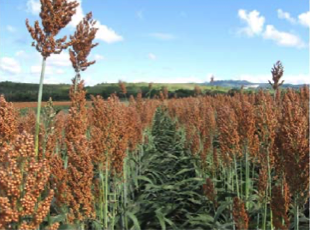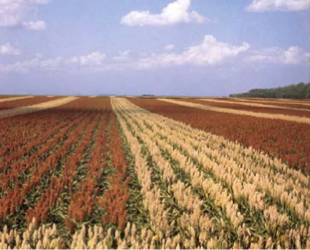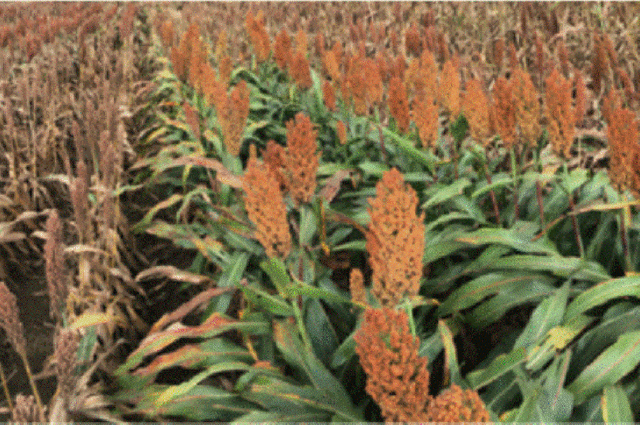What causes Taller Plants in Grain Sorghum Fields
Introduction
In the production of grain sorghum hybrids, the methods used by the seed industry to produce the crop allows for the potential of "off-types" to be present in the seed. To produce the hybrid cross, a male sterile of one genetically distinct inbred is pollinated by another inbred. Viable sorghum pollen can be blown from other sorghum fields as far as 10 miles away from the seed production field. If pollen is received from a source other than the intended inbred, the result is an off-type. There are five basic off-types recognized which include: mutation, grain outcross, grain forage, open head forage and Johnsongrass outcross.
The Five Groups of Off-Types
Grain Mutation
Mutation is the most prevalent off-type within the grain hybrid. Mutations occur naturally within the crossing of two inbreds. The mutation is identical to the hybrid with the exception of the number of plant-height controlling drawfing genes. The mutation will have the same head type, grain color and genetic makeup as the hybrid. However, mutations are usually 1 to 2 feet taller than the grain hybrid. Soil moisture conditions during the growing season will dictate the height expression of the mutation. You will see a higher percent of expression of taller grain mutant plants under better conditions, good early season moisture, on more productive soil types, under higher fertility management and in higher producing yields. The higher the yield, the more mutant plants you will see in a grain sorghum field. Most grain sorghum fields will express 1-2% taller grain mutants in farmer’s fields.

Grain Out-Cross
The grain out-cross off-type is caused when pollen from another grain sorghum source pollinates the sterile female parent within the seed field. The sorghum contaminant may be an off-type within the parent seed itself, or a commercial hybrid grown near the production area. The grain outcross will have a different head shape and/or color than the hybrid.
Grain Forage
The grain forage off-type is the result of pollen from a forage sorghum
(silage type) crossing with the female seed parent within the seed field. This
off-type can be the same height as a mutation, but is generally 2 to 4 feet
taller than the typical grain sorghum hybrid. The grain forage will typically
have a compact head similar to grain sorghum, but the stalk is usually more
robust. This off-type will produce very few tillers, but the plant height poses a problem during harvest of the grain sorghum. The heads of the grain forage are often unharvestable by the combine and could create a volunteer concern the following year. This potential volunteer will segregate as either a grain sorghum plant or a tall grain forage plant.

Open Head Forage
The open head forage off-type is the result of pollen from an open-headed forage plant cross-pollinating with the seed field. The pollen source is usually sudangrass, but can also include shattercane or broomcorn. This non-rhizomatous grassy type plant is usually taller than grain sorghum. It produces many slender tillers with open heads that bear large amounts of viable seed, which can remain dormant for a long period of time. The open head forage off-type is objectionable, due to a grassy appearance and volunteer concerns.
Johnsongrass Outcross
The Johnsongrass outcross occurs when pollen from Johnsongrass pollinates the male sterile plant in the seed production field. This cross-pollination does not readily take place due to the genetic differences between grain sorghum and Johnsongrass. The Johnsongrass outcross is rhizomatous, taller than grain sorghum, and has slender stalks, which produce many tillers. Johnsongrass outcrosses are almost always sterile and thus do not usually produce viable seed. However, these outcrosses produce rhizomes, which can potentially survive mild winters and infestation reoccurs in subsequent growing seasons.
High Quality Sorghum Seed Production from Dyna-Gro
Dyna-Gro Seed insures everything possible to eliminate the occurrence of taller plants in sorghum fields through isolated seed production, keeping off type contaminates to a minimum, continually rouging seed production fields, physically reading and evaluating winter grow outs of each individual lot number and running electrolysis tests for genetic purity of each lot number of seed. But due to the nature of sorghum seed production along with the variance of the crop under varying environments – it is common to see a very low percentage of taller plants in most grain sorghum fields – especially under high management conditions.

©Copyright 2013. This information may have been accumulated from publicly available sources outside of Dyna-Gro Seeds, or its affiliates. Individual results may vary, and performance may vary from location to location and from year to year. This result may not be an indicator of results you may obtain as local growing, soil and weather conditions may vary. Dyna-Gro® is a registered trademark of Loveland Products, Inc. Featured logos are service/trademarks of their respective owners.

